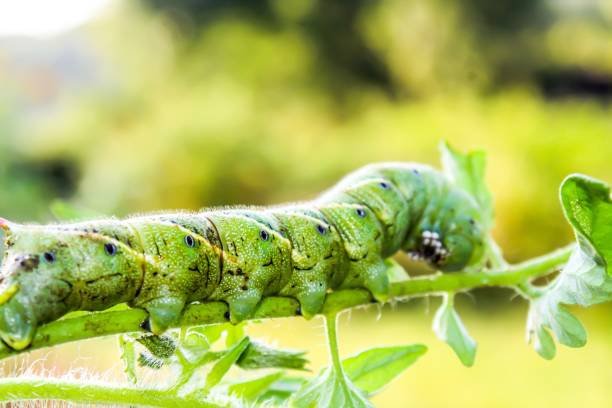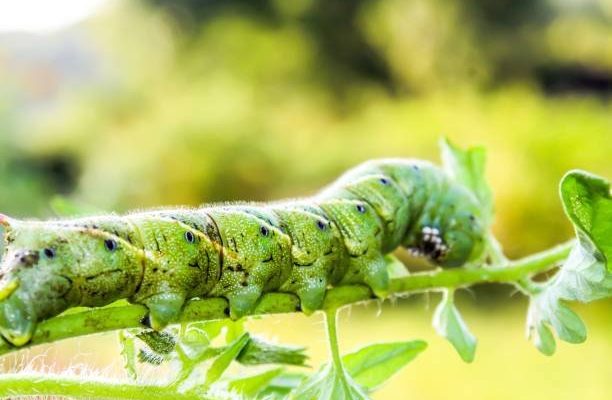
Think of diatomaceous earth (DE) as nature’s tiny, sharp swords. It’s made from the crushed remains of tiny aquatic organisms known as diatoms. When insects come into contact with this powdery substance, it damages their exoskeleton, leading to dehydration and eventually death. So, it’s a bit like a natural pest control method that doesn’t involve harsh chemicals. Let’s dive into how you can use diatomaceous earth for hornworm control and keep your garden thriving.
What Are Hornworms?
Hornworms, like the name suggests, have a distinct horn-like protrusion on their rear ends. They’re the larvae of the sphinx moth and can grow quite large, sometimes up to 4 inches long! These guys are particularly fond of plants in the nightshade family, which includes tomatoes, peppers, and eggplants.
You might spot them hanging out on the undersides of leaves or blending in with the stems, making them tricky to find. Their green coloring helps them camouflage perfectly. A hornworm can devour entire leaves or even stems in just one night! So, if you want to protect your plants, it’s crucial to act fast when you notice them.
How Diatomaceous Earth Works
So, how does diatomaceous earth work its magic? As mentioned earlier, this powder is made from tiny, fossilized aquatic organisms. When you sprinkle it in your garden, it doesn’t just create a barrier; it’s like laying down a minefield for pests.
Once the hornworm crawls across the DE, the tiny particles penetrate their soft bodies, causing them to dry out. Think of it like a sandpaper effect on their skin. It’s not instant, but it does the job—within a few days, those hornworms will be dealt with. Plus, DE is safe for plants and pets, which is a huge plus if you have a bustling garden.
Applying Diatomaceous Earth
Applying diatomaceous earth is pretty straightforward. Here’s a simple step-by-step process:
- Choose the Right Timing: Apply DE early in the morning or late in the afternoon when the sun is not as intense. This helps prevent the powder from blowing away.
- Dry Application: Use a duster or a garden sprayer to evenly spread the diatomaceous earth on and around affected plants. Make sure to coat the undersides of leaves as well.
- Reapply After Rain: Since DE is a powder, it can wash away with heavy rain or watering. Make it a habit to reapply after such weather events.
Following these steps should keep those hornworms in check!
Benefits of Using Diatomaceous Earth
Using diatomaceous earth for hornworm control offers several benefits. Firstly, it’s a natural solution, which means you don’t have to worry about harmful chemicals leaching into your soil. This is particularly important if you’re growing food for your family.
Another advantage is that DE is effective against a wide range of pests, not just hornworms. It can handle aphids, slugs, and even some types of beetles. So, when you sprinkle it in your garden, you’re creating a protective barrier against multiple threats.
Plus, diatomaceous earth is affordable and easy to find. You can pick it up at many garden centers or online, making it a convenient addition to your pest-control toolkit.
Potential Downsides
While diatomaceous earth is a fantastic option for controlling hornworms, there are a few things to keep in mind. One downside is that it can also harm beneficial insects, like ladybugs and bees. So, it’s essential to sprinkle it carefully to avoid affecting those helpful allies in your garden.
Another point to consider is that the effectiveness of DE can diminish if it gets wet or if your garden has a lot of rain. This is why regular reapplication is necessary to maintain its effectiveness.
Other Natural Hornworm Control Methods
If you’ve tried diatomaceous earth and still need more help, there are other natural methods to consider.
- Handpicking: Honestly, this might sound tedious, but sometimes the best method is the most straightforward. Get out there and remove hornworms by hand. Just check the leaves and stems and toss them into a bucket of soapy water to get rid of them.
- Beneficial Insects: Introducing natural predators, like parasitic wasps, can help control the hornworm population. These little wasps lay their eggs in hornworms, ultimately killing them.
- Neem Oil: This natural insecticide can disrupt the growth cycle of hornworms and other pests, making it harder for them to thrive.
It might be worth trying a combination of these methods alongside diatomaceous earth for the best results.
Final Thoughts
In the world of gardening, keeping pests at bay can feel like a constant battle. But with **diatomaceous earth**, you’ve got a powerful, natural ally in your corner. It’s effective against hornworms and so many other garden pests. Plus, it’s easy to use and safe for your plants.
Remember to apply it at the right time, reapply after rain, and consider combining it with other methods for maximum protection. As you navigate the ups and downs of gardening, having a dependable plan for hornworm control can help your plants not just survive, but thrive. Here’s to a healthy, pest-free garden!

